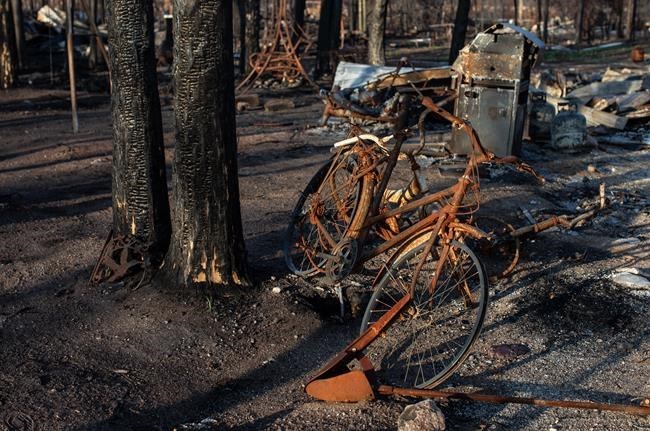OTTAWA — Persistent drought and months of above-average temperatures have escalated the risk of another record-breaking wildfire season, federal ministers said Wednesday as they warned about the urgent need to address climate change.
"We can expect that the wildfire season will start sooner, end later and potentially be more explosive," Emergency Preparedness Minister Harjit Sajjan told a news conference Wednesday.
The 2023 fire season was Canada's worst on record, with more than 6,600 fires burning more than 15 million hectares, an area almost twice the size of Lake Superior. It forced more than 230,000 people from their homes — including the entire city of Yellowknife — and created unprecedented smoke conditions across much of the country and into the United States.
Eight firefighters died battling the blazes and Canada expects to spend more than $750 million in disaster assistance alone. That does not include the billions of dollars spent fighting the fires in the first place.
A briefing document forecasting the fire risk for this spring shows conditions are already ripe for an early and above-normal fire risk from Quebec all the way to British Columbia in both April and May.
The forecast is based on having had a warmer-than-normal winter with minimal snow and widespread drought, particularly in the Prairies. There is also a high probability for above-normal temperatures in April, May and June. Western Canada, eastern Ontario and western Quebec are currently facing the highest risk.
The briefing includes a caveat that forecasting precipitation levels is not very reliable so the warnings are based on current conditions, and could change if more rain falls this spring than is currently expected.
The 91Ô´´ Interagency Forest Fire Centre lists 65 fires already burning, mainly in B.C., Alberta and the Northwest Territories. More than half are fires that started in 2023, smouldered underground throughout the winter and have since re-emerged. Most of the fires currently burning are under control.
Human activity is typically the main fire risk factor in the spring, said Michael Norton, the director general of the Northern Forestry Centre at Natural Resources Canada.
Preventing fires from starting in the first place is critical, and in the spring most fires are human-caused, including through careless burning, campfires, fireworks, and the heat from off-road vehicles igniting grass or other debris on the ground.
Lightning becomes a primary source of wildfires during the summer, once thunderstorms become more common.
About 70 per cent of the fires between January and May 2023 were started by humans, compared with fewer than 20 per cent of the fires that started in June, July and August.
The low level of snow in most of Canada is among the key reasons for the higher risks this spring. British Columbia’s snowpack for April is at a record low 67 per cent, said Jonathan Boyd, a hydrologist with the BC River Forecast Centre.
"Typically speaking, drought and wildfire go hand in hand, so it's not setting up to be a great season," Boyd said.
"But it still just depends on what the weather conditions are. If we have last year's spring weather conditions this year, it will be worse."
Sajjan said Canada and the provinces and territories have been working for months to prepare for a bad fire season this year and will be ready.
That includes more equipment and more trained firefighters, said Natural Resources Minister Jonathan Wilkinson. Ottawa now has agreements with 11 of the 13 provinces and territories to deliver $256 million in firefighting equipment, including trucks, drones and planes.
Wilkinson also said the 2022 promise to train 1,000 firefighters over five years may end up producing that many before the end of 2024. Some of that training includes urban firefighters, who need additional training to handle wildfires as they increasingly bear down on cities and towns.
On Wednesday, Sajjan said the government is also responding to the need for more hands on deck by doubling the tax credit for volunteer firefighters from $3,000 to $6,000, largely as a recruitment and retention tool.
Ken McMullen, president of the 91Ô´´ Association of Fire Chiefs, said the chiefs had asked for a $10,000 credit, but this is a good start.
"While this particular credit most benefits volunteer firefighters, there is a ripple effect to the entire fire service," McMullen said in an interview. "Although it's not quite where we wanted it to be, we are recognizing this as a positive move in the right direction."
NDP MP Gord Johns, who has also long advocated for the credit to go to $10,000, agreed that the government's move was a good start but not enough. Johns said Canada has lost 30,000 volunteer firefighters and search and rescue personnel since 2016.
"We need to do everything we can to try to ensure that we support recruitment," he said.
Johns also said Canada needs to invest in a national firefighting team, with 400 personnel and a fleet of planes to support provinces.
With the coming fire season looking to be as bad as 2023, if not worse, "the federal government needs to step up their game," Johns said.
This report by The 91Ô´´ Press was first published April 10, 2024.
— with files from Lyndsay Armstrong in Halifax and Brieanna Charlebois in 91Ô´´
Mia Rabson, The 91Ô´´ Press
Note to readers: This is a corrected story. An earlier version incorrectly identified NDP MP Gord Johns.



